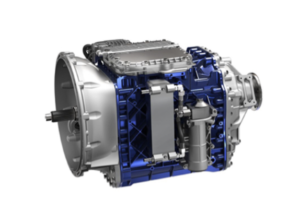Powertrain engineering Volvo uses to increase fuel efficiency
- January 23, 2023
- Blog
- Posted by Derick
- Leave your thoughts
In a recent blog post we discussed how Volvo uses aerodynamics into their optional fuel efficiency packages to help reduce air resistance, which when combined with the power train can increase fuel efficiency from 12 – 16%.
As any trucker knows, improvements of that magnitude will leave a small fortune in the pocket of the truck driver and not the diesel fuel companies. Today we’ll discuss how the power train contributes to this massive savings. For this, we’ll have to start with the D-13 TC (turbo compound) engine. It is the most fuel efficient engine Volvo offers. It utilizes a waste heat recovery system whereby it takes normally wasted heat and turns it into power and energy.
The D-13 TC is then mated to Volvo’s I-shift automated transmission. The Volvo i-Shift transmission is a automated manual transmission (AMT) that can help improve fuel efficiency by optimizing shifting patterns based on factors such as engine load, vehicle speed, and grade. The i-Shift transmission is able to anticipate the driver’s needs and preselect the next gear, which helps to reduce fuel consumption by minimizing the time the engine spends outside of its most efficient operating range.
In addition to optimizing shifting patterns, the i-Shift transmission also includes a number of other fuel-saving features. For example, it can automatically shut off the engine when the vehicle is stationary, reducing fuel consumption in traffic. It can also recover energy during braking and store it in the vehicle’s batteries, which can then be used to power the vehicle’s electrical systems and reduce the load on the engine.
Next is Volvo’s I-See technology. Volvo’s I-See uses a camera and GPS to gather information about the vehicle’s surroundings and optimize the transmission’s shifting patterns to improve fuel efficiency. The system is able to learn the topography of the road ahead and store this information in its onboard computer, allowing it to anticipate changes in the road and preselect the appropriate gear. This can help to reduce fuel consumption by minimizing the time the engine spends outside of its most efficient operating range.
In addition to optimizing shifting patterns, the i-See system can also use the stored topographic information to optimize the vehicle’s speed and acceleration. By smoothing out the vehicle’s speed and acceleration, the system can help to reduce fuel consumption and improve fuel efficiency.
When these features and their corresponding benefits are combined with the aerodynamic features we discussed in our last blog (titled: Aerodynamic engineering Volvo uses to increase fuel efficiency) together with the powertrain elements we discussed today it can translate into increased fuel efficiency anywhere from 12 – 16%! Volvo has an excellent calculator that can estimate roughly how much money you will save with various rigs here https://www.volvotrucks.us/trucks/powertrain/d13tc/turbo-compounding-calculator/


